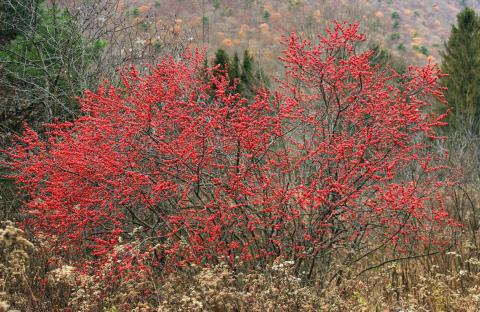What are the beautiful red berries by the side of the road?

Once the leaves have dropped, a native shrub called winterberry (Ilex verticillata) becomes especially noticeable in the landscape. Winterberry is a deciduous holly species that grows commonly in swamps, wetlands, damp wood edges, along the edges of ponds and streams and in roadside ditches throughout New Hampshire. Showy, clustered red berries are very noticeable in the fall and persist on branches well into the winter months, explaining how winterberry got its name. It is often considered one of the best plants for providing winter interest in the garden.
Winterberry has the potential to grow 6 to 10 feet high and wide, making it a good planting choice for shrub borders and hedges, especially along the edges of ponds or drainage ditches. Mature shrubs tend to be oval to rounded, with dense, twiggy branches throughout. Over time, new growth develops from the crown of the plant and larger roots to form a thicket.
Winterberry prefers full sun and moist, acidic soil but can tolerate part shade and either well-drained or boggy soils, which means it can be grown in almost any garden setting. In the spring and summer, it has dark green leaves that create an attractive screen or backdrop for other plantings. Inconspicuous flowers are borne on new growth in late spring and give way to showy berries later in the season. Like other species of holly, winterberry plants are either male or female, and both must be grown in the same general vicinity to produce berries.
Winterberry as a Food Source for Birds
Outside of being visually appealing, winterberries can provide valuable food for birds in the winter. Though the fruit does not have the highest nutritional quality, many bird species will eat the fruits when other foods are no longer available. Gray Catbirds, Northern Mockingbirds, Brown Thrashers, and American Robins preferentially feed on winterberry. Other birds may also use it for nesting in the spring, such as Cedar Waxwings and Red-winged Blackbirds. For these reasons, winterberry is almost always included on recommended planting lists for wildlife.
Purchasing Winterberry Shrubs
Those looking to purchase winterberry shrubs for the landscape will be faced with making a choice between dozens of different cultivated varieties. Many of these plants have been selected for especially large and abundant fruit, such as ‘Winter Red’ and ‘Red Sprite,’ or unusual yellow or orange berries as in the case of ‘Winter Gold.’ Winterberry (Ilex verticillata) has also been hybridized with Japanese winterberry (Ilex serrata) to create more vigorous shrubs. A few of the more popular forms are ‘Sparkleberry,’ ‘Autumn Glow’ and ‘Bonfire.’
To complicate matters further, all winterberry cultivars and hybrids must be matched with an appropriate male plant to achieve adequate pollination and berry set. If the goal is to plant winterberries exclusively for ornamental purposes, any of these plants will make a nice addition to the landscape. However, in terms of gardening for wildlife, personal observation indicates that birds tend to prefer straight species winterberry fruits over cultivated varieties and hybrids. As the winter progresses, though, even unusual fruits will be consumed.
In summary, winterberry is an all-around excellent native plant for the garden and landscape. Even if you don’t try to grow it in your own yard, you can enjoy it in the wild every fall.
Got questions? The Ask UNH Extension Infoline offers practical help finding answers for your home, yard, and garden questions. Call toll free at 1-877-398-4769, Monday to Friday, 9 a.m. to 2 p.m., or e-mail us at answers@unh.edu.
Image by Nicholas A. Tonelli
Related Resource(s)
Do you love learning about stuff like this?
SUBSCRIBE TO Granite State Gardening newsletter
Got questions? The UNH Extension Yard and Garden Infoline offers practical help finding answers for your yard and garden questions.
Call toll free at 1-877-398-4769, Monday to Friday, 9 a.m. to 2 p.m., or fill out webform.
